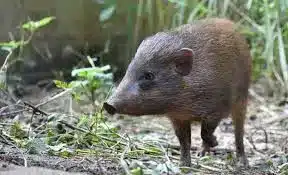About Pygmy hog:
- It is the smallest and rarest species of wild pig in the world.
- It is one of the very few mammals that build its own home, or nest, complete with a ‘roof’.
- It is an indicator species as its presence reflects the health of its primary habitat, tall and wet grasslands.
- Habitat: It prefers undisturbed patches of grassland dominated by early succession riverine communities, typically comprising dense tall grass intermixed with a wide variety of herbs, shrubs and young trees.
- Currently, the viable population of this pig in the wild is in the Manas Tiger Reserve in Assam.
- Conservation status:
- IUCN: Critically Endangered
- The Wildlife Protection Act, 1972: Schedule I
Key facts about Manas National Park
- It is located in the state of Assam. It is contiguous with the Royal Manas National Park in Bhutan.
- It is a national park, UNESCO Natural World Heritage site, a Project Tiger reserve, an elephant reserve and a biosphere reserve.
- Rivers: The Manas River passes through this park
- Flora: It contains some of the largest remaining grassland habitats in the sub-Himalayan grassland ecosystems.
- Fauna: It is known for its rare and endangered endemic wildlife such as the Assam roofed turtle, hispid hare, golden langur and pygmy hog.
Q1: What is Captive breeding?
It means that members of a wild species are captured, then bred and raised in a special facility under the care of wildlife biologists and other experts. It is considered as a Conservation Tool.
Source: Nine captive-bred pygmy hogs released in Assam national park
Last updated on July, 2025
→ UPSC Notification 2025 was released on 22nd January 2025.
→ UPSC Prelims Result 2025 is out now for the CSE held on 25 May 2025.
→ UPSC Prelims Question Paper 2025 and Unofficial Prelims Answer Key 2025 are available now.
→ UPSC Calendar 2026 is released on 15th May, 2025.
→ The UPSC Vacancy 2025 were released 1129, out of which 979 were for UPSC CSE and remaining 150 are for UPSC IFoS.
→ UPSC Mains 2025 will be conducted on 22nd August 2025.
→ UPSC Prelims 2026 will be conducted on 24th May, 2026 & UPSC Mains 2026 will be conducted on 21st August 2026.
→ The UPSC Selection Process is of 3 stages-Prelims, Mains and Interview.
→ UPSC Result 2024 is released with latest UPSC Marksheet 2024. Check Now!
→ UPSC Toppers List 2024 is released now. Shakti Dubey is UPSC AIR 1 2024 Topper.
→ Also check Best IAS Coaching in Delhi















